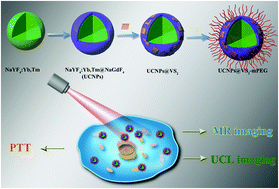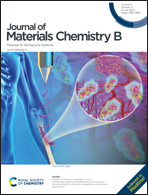Nanostructures based on vanadium disulfide growing on UCNPs: simple synthesis, dual-mode imaging, and photothermal therapy†
Abstract
It remains a great challenge to integrate effective photothermal therapeutic materials with upconversion nanoparticles (UCNPs) into one structure with small size. Herein, a new and simple method was developed to combine the luminescent UCNPs with vanadium disulfide (VS2) heterogeneously growing on the UCNPs. VS2 was grown directly on the surface of UCNPs to obtain oil-soluble nanocomposites, UCNPs@VS2. Then polyethylene glycol (mPEG) was functionalized on the surface of the nanocomposites to improve the water solubility, resulting in the integrated nanostructure UCNPs@VS2-mPEG (with an approximate size of 25 nm) for bioimaging and photothermal therapy in vitro. Importantly, cytotoxicity test results show that the final nanostructure has good biocompatibility. Furthermore, due to the excellent photothermal effects of VS2 and the unique imaging function of UCNPs, the nanostructure shows effective photothermal therapy for HeLa cells and was successfully applied in magnetic resonance imaging and upconversion luminescence imaging in vitro. Therefore, this study demonstrates a simple yet powerful method of growing VS2 on the surface of UCNPs, which provides an effective method to establish one integrated nanostructure with a nanoscale advantage for dual-model bioimaging and treatment.



 Please wait while we load your content...
Please wait while we load your content...